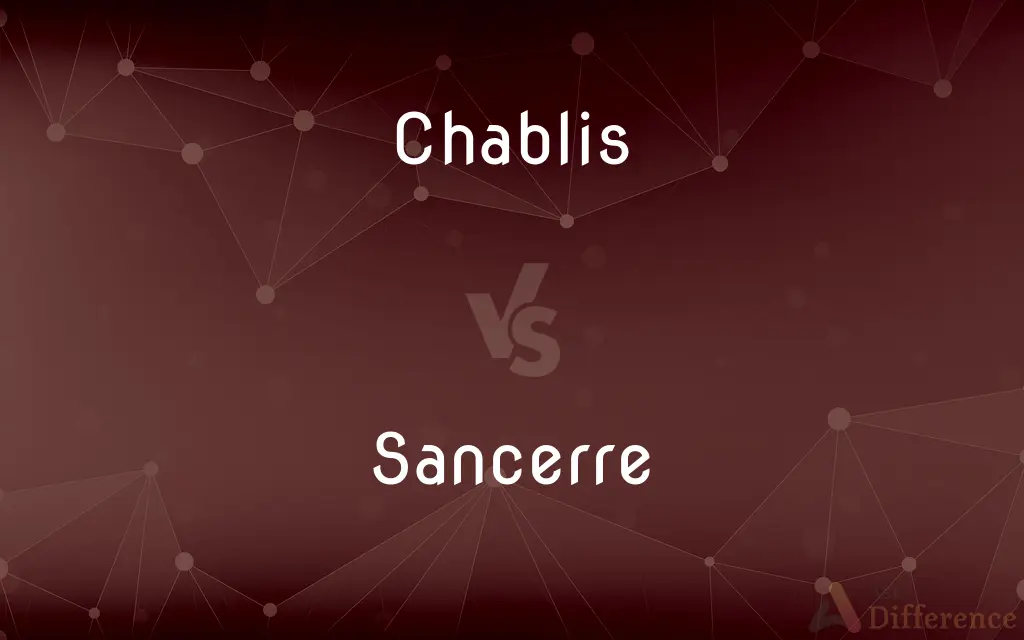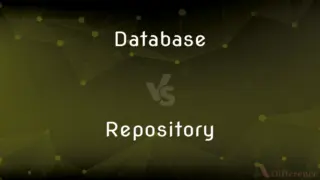Chablis vs. Sancerre — What's the Difference?
Edited by Tayyaba Rehman — By Urooj Arif — Updated on April 16, 2024
Chablis is a French wine known for its crisp, mineral flavors derived from Kimmeridgian soil, predominantly featuring Chardonnay; Sancerre, also French, is famed for its aromatic, crisp Sauvignon Blanc, influenced by its distinct terroir.

Difference Between Chablis and Sancerre
Table of Contents
ADVERTISEMENT
Key Differences
Chablis wines are celebrated for their pure expression of Chardonnay, showcasing a flinty minerality and high acidity, developed in Burgundy's cool climate. Sancerre wines, on the other hand, highlight Sauvignon Blanc's vibrant and herbaceous characteristics, thriving in the cooler climate of the Loire Valley.
The soil in Chablis contains Kimmeridgian limestone, rich in marine fossils, which imparts a unique mineral taste to its wines. Whereas, Sancerre’s terroir varies, including limestone and flint, which contribute to its wines' notable complexity and crispness.
Chablis typically undergoes a more restrained winemaking process to preserve the grape's inherent qualities, often using stainless steel for fermentation. Sancerre winemakers, meanwhile, might experiment with both stainless steel and oak barrels to enhance the aromatic profile.
The typical profile of a Chablis includes green apple, lemon, and oyster shell, reflecting its cool, continental climate. Sancerre wines often exhibit flavors of gooseberry, white peach, and nettles, influenced by their slightly warmer, semi-continental climate.
Chablis is generally more structured and can age well due to its acidity and minerality. Sancerre, while also capable of aging, tends to be enjoyed for its youthful freshness and zesty fruit notes.
ADVERTISEMENT
Comparison Chart
Primary Grape
Chardonnay
Sauvignon Blanc
Region
Burgundy, France
Loire Valley, France
Soil Type
Kimmeridgian limestone
Limestone, flint, and clay
Wine Character
Flinty, mineral, structured
Aromatic, crisp, herbaceous
Typical Flavors
Green apple, lemon, oyster shell
Gooseberry, white peach, nettles
Compare with Definitions
Chablis
Characterized by crisp acidity and flinty flavors, often aged in stainless steel.
I love the crisp acidity of this young Chablis.
Sancerre
Originates from the Loire Valley, known for its crisp and aromatic profile.
The aromatic profile of this Sancerre is remarkably refreshing.
Chablis
A dry white wine from the Burgundy region of France, known for its purity and minerality.
The Chablis paired beautifully with the seafood platter.
Sancerre
Features flavors of citrus, peach, and herbs, reflecting its diverse terroir.
You can taste hints of peach and herbs in this Sancerre.
Chablis
Served chilled, often as an accompaniment to oysters or shellfish.
Serve this Chablis chilled for the best taste experience.
Sancerre
A distinctive French white wine predominantly made from Sauvignon Blanc.
Sancerre is my go-to wine for a light summer evening.
Chablis
Typically consumed within a few years of bottling, but capable of aging well.
Aged Chablis develops complex flavors over time.
Sancerre
Best enjoyed young to appreciate its freshness and zest.
This young Sancerre is exceptionally zesty and fresh.
Chablis
Made exclusively from Chardonnay grapes, expressing a unique regional terroir.
This Chablis exhibits the classic characteristics of its Kimmeridgian soil.
Sancerre
Often used as an aperitif or paired with goat cheese and fish dishes.
Pair this Sancerre with goat cheese for a delightful combination.
Chablis
Chablis (French pronunciation: [ʃabli] (listen)) is a town and commune in the Yonne department in Bourgogne-Franche-Comté in north-central France. It lies in the valley of the River Serein.
Sancerre
Sancerre (French pronunciation: [sɑ̃sɛʁ] (listen)) is a medieval hilltop town (ville) and commune in the Cher department, France overlooking the river Loire. It is noted for its wine.
Chablis
A very dry white Burgundy wine originally from east-central France.
Sancerre
A dry, typically white wine from the upper Loire River valley.
Chablis
A blended white table wine of California.
Chablis
Alternative case form of Chablis
Chablis
A white wine made near Chablis, a town in France.
Chablis
A white wine resembling Chablis{1}, but made elsewhere, as in California.
Chablis
A town in north central France noted for white Burgundy wines
Chablis
Dry white table wine of Chablis, France or a wine resembling it
Common Curiosities
What food pairings work best with Chablis?
Chablis pairs excellently with seafood, especially oysters and shellfish, due to its crisp acidity and mineral undertones.
Can Chablis be made using oak aging?
While traditionally Chablis is aged in stainless steel to maintain its purity and minerality, some producers use oak barrels to add complexity.
How do the soils of Chablis affect its wine profile?
The Kimmeridgian limestone in Chablis, rich in marine fossils, gives the wine its distinct minerality and flinty character.
What are the aging potentials of Chablis and Sancerre?
Chablis can age well for several years due to its high acidity and mineral structure, while Sancerre is usually best enjoyed within a few years to appreciate its freshness.
How does the winemaking process differ between Chablis and Sancerre?
Chablis winemakers typically focus on maintaining the grape's natural characteristics with minimal intervention, whereas Sancerre winemakers may use both stainless steel and oak to vary the aromatic profile.
How do the climates of Chablis and Sancerre's growing regions differ?
Chablis, in Burgundy, has a cool continental climate, which is ideal for developing its crisp, acidic profile, whereas Sancerre, in the Loire Valley, experiences a slightly warmer, semi-continental climate that helps develop more fruit-forward and herbaceous notes.
Are there any notable vintages for Chablis or Sancerre?
Specific vintages vary by year and conditions, but generally, cooler years that allow slow maturation are ideal for both Chablis and Sancerre, enhancing their respective flavor profiles.
What food pairings are ideal for Sancerre?
Sancerre is a great match for goat cheese, fish, and poultry, complementing their flavors with its crisp, aromatic qualities.
What impact do current climatic changes have on Chablis and Sancerre wines?
Warmer temperatures can lead to earlier harvests and potentially fuller-bodied wines, affecting the traditional flavor profiles known for their crispness and acidity.
What are the legal requirements for a wine to be labeled as Chablis or Sancerre?
Both must meet AOC (Appellation d'Origine Contrôlée) regulations, which include specific geographic boundaries, grape varieties, and winemaking practices.
What is the best serving temperature for Chablis and Sancerre?
Chablis should be served chilled, around 10-12°C (50-54°F), and Sancerre slightly warmer at around 12-14°C (54-57°F).
Can Sancerre wines be red or rosé?
Yes, although best known for its white wines, Sancerre also produces red and rosé wines primarily from Pinot Noir.
Are there any organic or biodynamic producers in Chablis and Sancerre?
Yes, both regions have seen a rise in organic and biodynamic practices, with producers focusing on sustainability and terroir-driven expressions.
What are the sub-regions of Chablis and do they differ in style?
Chablis has four appellations: Petit Chablis, Chablis, Chablis Premier Cru, and Chablis Grand Cru, each offering increasing complexity and aging potential.
How does the mineral content of Chablis and Sancerre's soils compare?
Chablis' soils are high in limestone and clay with marine fossil imprints, contributing to its mineral taste, whereas Sancerre's soils, including flint and limestone, provide a different but equally mineral complexity to the wines.
Share Your Discovery

Previous Comparison
Festa vs. Festival
Next Comparison
Database vs. RepositoryAuthor Spotlight
Written by
Urooj ArifUrooj is a skilled content writer at Ask Difference, known for her exceptional ability to simplify complex topics into engaging and informative content. With a passion for research and a flair for clear, concise writing, she consistently delivers articles that resonate with our diverse audience.
Edited by
Tayyaba RehmanTayyaba Rehman is a distinguished writer, currently serving as a primary contributor to askdifference.com. As a researcher in semantics and etymology, Tayyaba's passion for the complexity of languages and their distinctions has found a perfect home on the platform. Tayyaba delves into the intricacies of language, distinguishing between commonly confused words and phrases, thereby providing clarity for readers worldwide.















































